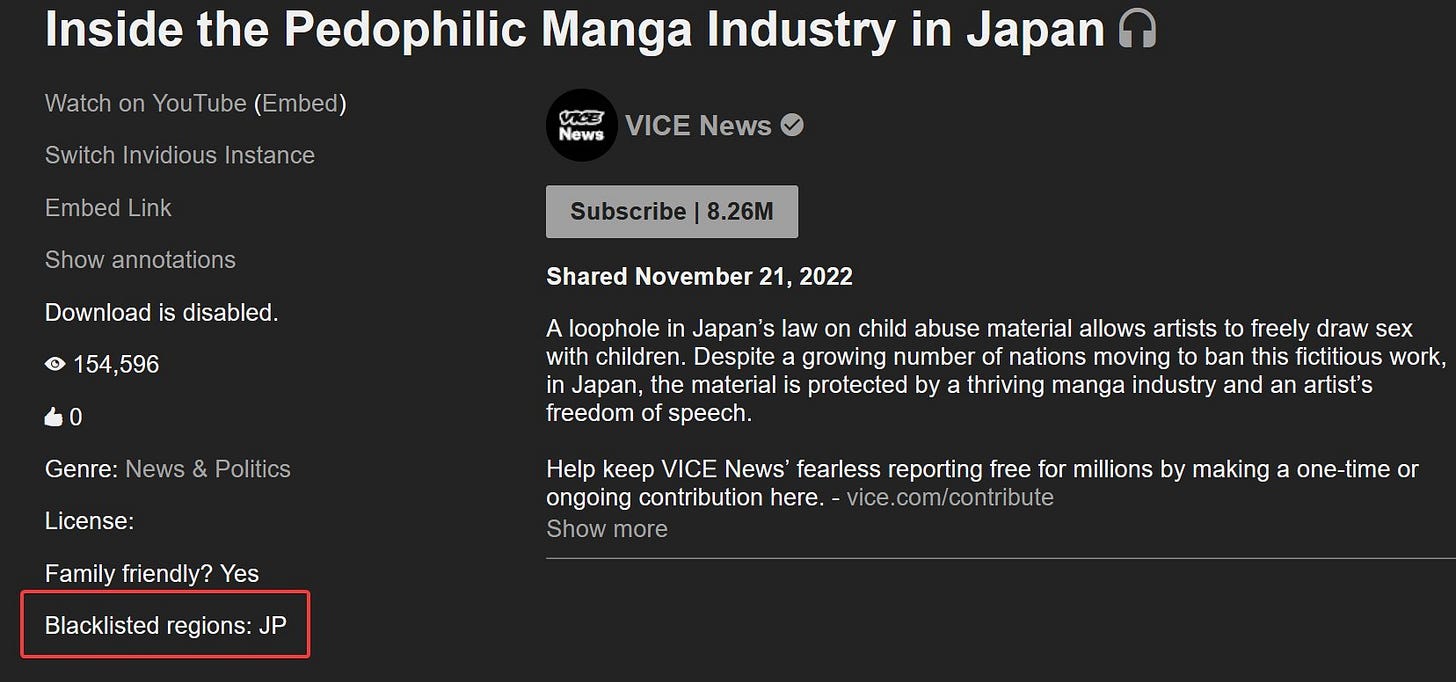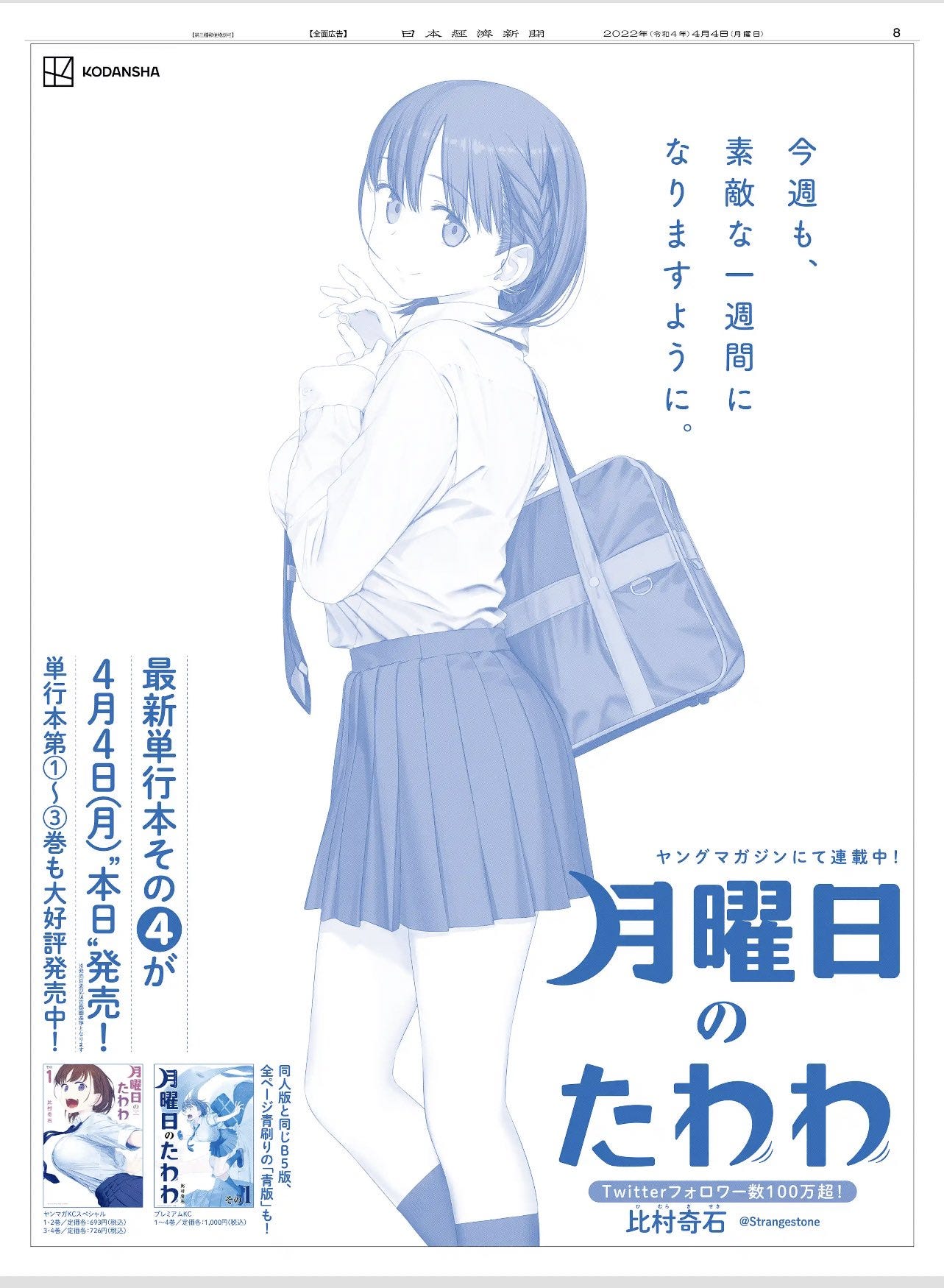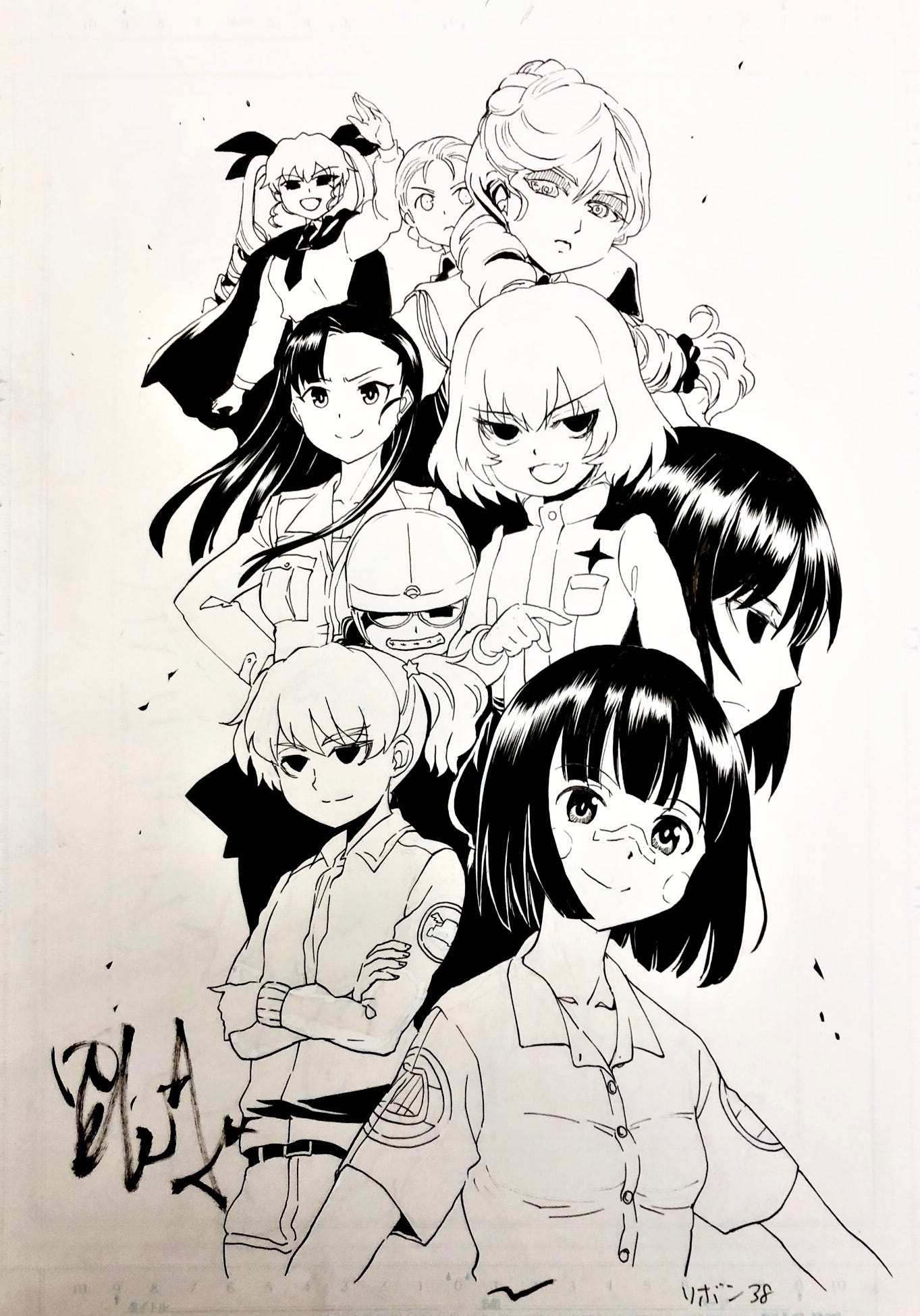Weird Japan - On Western Critiques of Anime and Manga
Amid the chorus of praise and sustained popularity, some Western critics continue to smear anime and manga, depicting Japanese culture as strange and sinister.
Disclaimer: This article was originally posted on Anime Corner as a guest feature on May 10, 2023 and has only been slightly edited for re-publication. The original piece can be found here.
Having previously written about the successes of Japan’s manga and anime industries, it’s not hard to conclude that Japan’s anime and manga remain as successful as ever. By the end of 2021, domestic manga sales totaled ¥675.9 billion (about $5.3 billion), while direct Western comic sales to North America were worth $600 million. Animated works as varied as Cyberpunk Edgerunners (2022) and JoJo’s Bizarre Adventure: Stone Ocean (2021–22) have received critical accolades, while Makoto Shinkai’s Suzume (2022) continues to make waves globally.
Yet, amid the chorus of praise and sustained popularity, some Western critics continue to highlight what they see as the problematic nature of those genres and their fandoms, often echoing a kind of weird Japan narrative and depicting Japanese culture as strange and sinister.
“Weird Japan”
On December 17, 2020, Ryu Spaeth wrote a piece for The New Republic, admonishing the “Weird Japan” trap many writers in the West seem to fall into.
Japan, in this mindset, is a place where “men fall in love with busty Power Rangers, and the women vanish like ghosts into the gloomy mist of the suicide forest.”
Such writers seem to project their own anxieties about their societies’ growing atomization, sexual degeneracy, and demographic decline onto Japan.
It’s not a stretch, therefore, to see how these are extended to manga, anime, and their fans, who seem to typify all those worrying tendencies.
Critics have, thus, often described the genres as misogynistic claiming that they sexualize female characters and pander to lonely otaku (obsessive, housebound geeks). Worse, it’s claimed, they can even enable abusers and pose social harm.
On February 26, 2020, Australian senator Stirling Griff, bemoaning the “dark side and a disgusting side to anime and manga,” called for a censorious review of all exported works from Japan available in his country, including No Game, No Life, over fears of harmful content.
Washington Post contributors Michelle Ye Hee and Julia Mio Inuma used their September 18, 2021 review of Mamoru Hosoda’s Belle to lament about problematic representation in the industry, positing that positive LGBT portrayals did not exist until more recently.
On April 15, 2022, Huffington Post Japan reported that the United Nations-aligned organization UN Women filed a complaint against Japanese newspaper giant Nikkei over advertising Tawawa on Monday manga, which has been running since 2020 and which allegedly presents “an underage girl as a male sexual target.” Critics commented on the fetishization of high school girls and their uniforms in Japan, which is seen as problematic due to harassment in public places, among other things.
On September 1, 2022, journalist Sasha Kong cited Patrick Galbraith’s claim that Japanese media production “has been heavily tilted towards men since its early formations in the post-war period.” This is seen as proof of the problematic hypersexualized portrayals of women contained in anime and manga, which are now being challenged by “feminist storytelling.”
In both a November 12, 2021 article and a November 22, 2022 documentary for VICE News —which was controversially blocked by YouTube in Japan— Hanako Montgomery alleged that such media “may leave room to normalize sexual violence against children.” Manga creators are also framed as using creative freedoms as a “loophole” that justifies creating problematic, harmful content.
Such charged critiques, however, struggle when brought up to close scrutiny.
Academic Nele Noppe, in a paper originally published on September 3, 2014, discussed the significant role women played in shaping the industry, both as creators and fans, as early as the 1970s. This was something that’s attested to by Gundam creator Yoshiyuki Tomino’s recurring comments about the franchise having fostered a large female fandom from the beginning.
On February 12, 2016, writer/translator Dan Kanemitsu rebutted similar, earlier criticisms from UN bodies about manga and anime’s perceived harmful content, as they conflate wholly fictional creations with abuse directed at real people and do not reflect the views of creators or fans.
These were echoed in a February 28, 2016 memorandum in defense of creative freedoms and women’s role in the industry from Japan Women’s Institute of Contemporary Media Culture representative Kumiko Yamada, signed by various mangaka and academics.
In an op-ed by Tatsuo Tanaka for Keio University’s SYNODOS on April 20, 2022, most Japanese found nothing problematic in Tawawa on Monday to warrant censorship, with younger women expressing more tolerance over the work and advertising. While the work does touch upon the aforementioned fetishization due to some of its female characters being high school girls, as highlighted by long-time blogger The Infinite Zenith, it is neither more risqué nor inappropriate than most primetime anime.
Irodori Comics owner On Takahashi remarked in a November 22, 2022 Twitter thread that Montgomery’s exposé mistakes fantasy for reality, further remarking how there’s been no proven correlation between the popularity of explicit animation and the prevalence of exploitation.
Retorts aside, a cursory glance at the modern anime and manga scene can paint a lie to the stereotypes. Provocative works of various kinds have been made by female creators over the years, with popularity transcending gender and demographics. Such works included Hiromu Arakawa’s Fullmetal Alchemist (which often touched on socio-political issues in the context of the story), Iida Pochi’s Lovecraftian The Elder Sister-like One (which notably treats its explicit doujin content as canonical) and the works of both Naoko Takeuchi and the all-female CLAMP circle (which have touched on LGBT motifs long before they became mainstream).
This is not to say that anime and manga haven’t had controversies or claims from domestic Japanese sources that seemingly lend weight to Western criticisms. Here are some of the more often-invoked:
It wasn’t until June 18, 2014, that the Japanese government formally and explicitly outlawed the possession of explicit content showing children. It’s worth noting that the legislation, which also bans production and distribution has been in place since 1999.
On November 21, 2017, mangaka Nobuhiro Watsuki of Rurouni Kenshin fame was apprehended following his admission of possessing said explicit material. Though he was only given a fine instead of jail time, this continues to haunt discussions around him and his work years after. In addition to being fined, Watsuki’s work is currently being serialized.
Manga magazine Weekly Shonen Jump announced on August 10, 2020 its abrupt cancellation of Act Age in the wake of author Tatsuya Matsumoto’s arrest in June of that same year, over inappropriate acts with “two junior high school girls on the streets of Tokyo.”
Please Tell Me! Galko-chan creator Kenya Suzuki was arrested on December 20, 2021, on charges of possessing illegal, dubious photographs imported from Germany among other incriminating material. He got a three-year suspended sentence.
Kazuna Kanajiri, the chief director of PAPS – an NGO catering to sexual exploitation survivors cited by Montgomery in her 2022 documentary for VICE News – referred to the existence of provocative manga as a “violation of human rights” which must be curtailed to protect women and children.
Those being said, it is disingenuous to paint Japanese pop culture and fandom at large as being morally repugnant when such cases are exceptions rather than the norm. Nuance, however, is not what weird Japan narratives are known for.
Another long, disingenuous history
Neither did these demeaning narratives come out of nowhere. Instead, weird Japan rhetoric has left behind a track record that transcends borders and institutions.
2017: BBC Three journalist Stacey Dooley accused artist Takeshi Nogami of enabling harmful material for children because of his work on Girls und Panzer, itself presented as problematic for featuring youthful female protagonists. Many of the points raised were eventually repeated by Montgomery in 2022.
2016: the Office of the UN High Commissioner for Human Rights called for a ban on “the sale of video games or cartoons involving sexual violence against women” in Japan and blamed such works for propagating sexist stereotypes.
2010: CNN’s Kyung Lah cited the example of a PC game by eroge studio Illusion as evidence of Japan’s moral depravity—even though the game in question had never been popular and was no longer in circulation by the time it was spotlighted.
2009: Roger Cohen wrote a New York Times op-ed depicting male fans of manga and anime as examples of the escapist follies of the modern Japanese. The country is described as leading “humanity’s rush into isolating forms of electronic obsession.”
2008: UNICEF appealed to the Japanese government to end harmful content “in manga comics, animated films and computer games”—despite a lack of evidence that these games harmed actual children.
1996: The first “World Congress Against Sexual Exploitation of Children and Adolescents” singled out Japan as a “major producer” of problematic content —even though the evidence presented did not suggest that Japan was an exceptional outlier at the time. The event also lumped together suggestive art, irrespective of the age of the characters portrayed, alongside real material.
1996: Both the conservative Familles de France and the socialist Ségolène Royale denounced anime and manga, contributing to France’s Comité de Surveillance Audiovisuel (known as the Regulatory Authority for Audiovisual and Digital Communication or ARCOM since 2022) attempting to ban both in the country over fears that such material might foster moral degeneracy.
Although this negative attention has yet failed to tarnish Japanese pop culture globally, it can make one wonder why it persists amidst all the rebuttals. These can’t simply be explained away as a couple of bad actors or nitpicking.
Pathologizing the Rising Sun?
Bloomberg journalist Gearoid Reidy sees the misunderstandings about the nature of anime and manga as symptomatic of an overall “growing gap in Western understanding of, and even interest in, Japan” despite the nation’s economic and cultural clout. This is elaborated further in his response to BBC correspondent Rupert Wingfield-Hayes’ January 20, 2023 article about how Japan is “stuck in the past” by questioning why the country should change to meet Western tastes at all.
Others, such as Youtuber Joey “The Anime Man” Bizinger in his March 9, 2017 response to Dooley’s BBC Three exposé on Girls und Panzer, have noticed how such sentiment doesn’t just betray a patronizing mindset not unlike the smears on Japanese gaming. It also reflects how those peddling weird Japan narratives tend to be more concerned about solving fictional, perceived problems rather than going after actual crimes much closer to home, whether over misplaced grandstanding or plain expediency.
A 2022 Spice “Asia Undercovered” interview with Hanako Montgomery, however, unintentionally sheds light on another reason behind the continued “popularity” of such claims, even among those claiming to fight them.
Montgomery presents her reporting as combatting misconceptions about Japanese culture, by delving into serious issues to bridge the gap between cultures, thus “expanding the conversation.”
She presents this under presumptions that freedom of speech “isn’t as strong of a value here in Japan,” and that owing to her mixed-race “privilege,” it’s also her duty to tear down positive stereotypes. Japanese “cute geeky culture” is subsequently suggested as one such distraction, preventing people from talking about human rights issues.
Rather than combating alarmist rhetoric or understanding Japan on its own terms, this reveals a persistent trend of pathologizing not only anime and manga but the Japanese themselves, as problematically alien with suspect morals. Whether out of righteous scorn or a patronizing desire to make the country “be better,” this isn’t just irresponsible reporting. Especially when aimed at audiences without any familiarity with the subject matter, this also guarantees that a cycle of mutual hatred will persist.
We shouldn’t make the mistake of viewing artistic freedom of expression as a threat in itself—no matter how emotively moralistic the appeals of activists may be. We must always take cultural preferences and creative liberties into consideration and not be blindly led by self-righteous indignation to demonize an art form with which they have never been linked, despite perennial attempts to find such a connection. Neither should we slander the Japanese as child abusers because of their taste in comics. Perhaps it’s better, at least, to try to give a fair shake than to peddle fear and disgust for personal gain.
Addendum (Apr. 12, 2024)
Since writing this post, I had touched on Japanese otakudom and censorship, as well as the VICE News documentary mentioned above, a few times. So what hasn’t been said already? As it turns out, the mere fact that the overall discourse has not only remained unchanged, but has arguably grown even more pronounced on social media, deserves highlighting in and of itself.
The narrative of anime and manga’s perceived degeneracy gained renewed traction earlier this year in the wake of political pundit Ian “Vaush” Kochinski being found with questionable phonographic material, including explicit anime art. None quite exemplified this than a video from Hunter August “Meatcanyon” Hancock on February 22. In addition to using terms like “anime fan” and “loli” nigh-interchangeably, there was an astonishing lack of research, in practice amounting to “if it quacks like a duck” grandstanding. It didn’t matter that the rhetoric wouldn’t be out of place in a Matt Walsh rant or how the creator’s portfolio, as highlighted by anime Youtuber Rev the next day, hypocritically featured sexualized parodies involving young characters and real child. As far as Meatcanyon and his fans were concerned, however, Japanese material was deeply gross, as opposed to Western “satire.”
As easy as it might seem to laugh it off or dismiss out of hand, this has only served underline how persistent the weird Japan trap truly is. Be it capitalizing on preexisting misconceptions or projecting socio-political talking points onto the country, there’s seemingly little effort to understand, let alone respect the country’s culture and media. These in turn contributed to what Oliver Jia described in his April 10 Foreign Perspectives piece as not simply the normalization of “arguments between people who know very little of what they’re talking about.” Combined with a disconcerting tendency to flout apparent Western moral superiority (regardless of political affiliation), it is only cultivating more radicalism, as well as those capitalizing on the outrage for their own ends.
Just as this has been the culmination of years’ worth of misinformation and bad-faith smears, this is likely to continue for the foreseeable future. That being said, this vicious cycle need to be the norm. It would also require some degree of vigilance and gatekeeping among anime and manga fans, however, stepping as needed to course-correct.
Perhaps it’s a thankless job. Maybe the idea of approaching Japanese media and the people who make or enjoy it might be a bridge too far for those unfamiliar with them. Yet compared to the alternative of dishonest reporting and censorious apologia masquerading as “critique,” it may be the most practical course of action there is.














